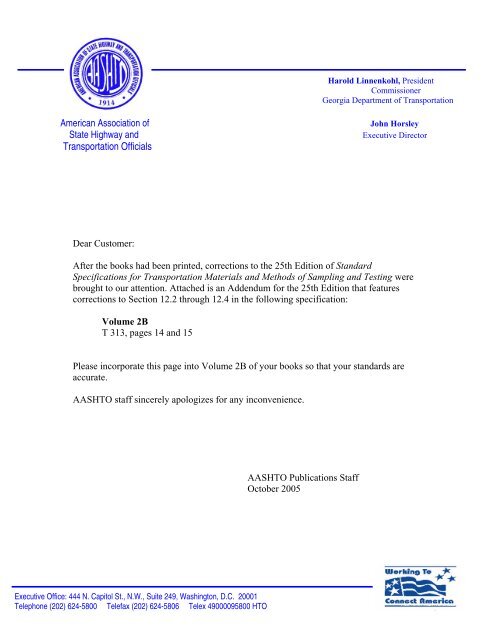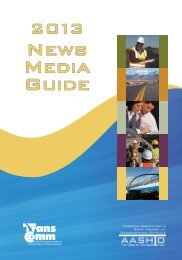Standard Specifications for Transportation Materials and Methods of ...
Standard Specifications for Transportation Materials and Methods of ...
Standard Specifications for Transportation Materials and Methods of ...
Create successful ePaper yourself
Turn your PDF publications into a flip-book with our unique Google optimized e-Paper software.
Harold Linnenkohl, President<br />
Commissioner<br />
Georgia Department <strong>of</strong> <strong>Transportation</strong><br />
American Association <strong>of</strong><br />
State Highway <strong>and</strong><br />
<strong>Transportation</strong> Officials<br />
John Horsley<br />
Executive Director<br />
Dear Customer:<br />
After the books had been printed, corrections to the 25th Edition <strong>of</strong> <strong>St<strong>and</strong>ard</strong><br />
<strong>Specifications</strong> <strong>for</strong> <strong>Transportation</strong> <strong>Materials</strong> <strong>and</strong> <strong>Methods</strong> <strong>of</strong> Sampling <strong>and</strong> Testing were<br />
brought to our attention. Attached is an Addendum <strong>for</strong> the 25th Edition that features<br />
corrections to Section 12.2 through 12.4 in the following specification:<br />
Volume 2B<br />
T 313, pages 14 <strong>and</strong> 15<br />
Please incorporate this page into Volume 2B <strong>of</strong> your books so that your st<strong>and</strong>ards are<br />
accurate.<br />
AASHTO staff sincerely apologizes <strong>for</strong> any inconvenience.<br />
AASHTO Publications Staff<br />
October 2005<br />
Executive Office: 444 N. Capitol St., N.W., Suite 249, Washington, D.C. 20001<br />
Telephone (202) 624-5800 Telefax (202) 624-5806 Telex 49000095800 HTO
Note 11—Asphalt binders may harden rapidly when held at low temperatures. This effect,<br />
which is called physical hardening, is reversible when the asphalt binder is heated to room<br />
temperature or slightly above. Because <strong>of</strong> physical hardening, conditioning time must be<br />
carefully controlled if repeatable results are to be obtained.<br />
12.2. After conditioning, place the test beam on the test supports <strong>and</strong> initiate the test. Maintain the<br />
bath at test temperature ±0.1°C during testing, otherwise the test shall be rejected.<br />
12.3. Enter the specimen identification in<strong>for</strong>mation, test load, test temperature, time the specimen is<br />
placed in bath at test temperature, <strong>and</strong> other in<strong>for</strong>mation as appropriate into the computer which<br />
controls the test system.<br />
12.4. Manually apply a 35 ± 10 mN contact load to the beam to ensure contact between the beam <strong>and</strong><br />
the loading head <strong>for</strong> no more than 10 seconds.<br />
Note 12—The specified contact load is required to ensure continuous contact between the<br />
loading shaft <strong>and</strong> support, <strong>and</strong> the specimen. Failure to establish continuous contact within the<br />
required load range gives misleading results. The contact load shall be applied by gently<br />
increasing the load to 35 ± 10 mN. While applying the contact load, the load on the beam shall<br />
not exceed 45 mN, <strong>and</strong> the time to apply <strong>and</strong> adjust the contact load shall be no greater than 10 s.<br />
12.5. Activate the automatic test system that is programmed to proceed as follows.<br />
12.5.1. Apply a 980 ± 50 mN seating load <strong>for</strong> 1.0 ± 0.1 second.<br />
Note 13—The seating loads described in Sections 12.5.1 <strong>and</strong> 12.5.2 are applied <strong>and</strong> removed<br />
automatically by the computer-controlled loading system <strong>and</strong> are transparent to the operator.<br />
Data are not recorded during the initial loading.<br />
12.5.2. Reduce the load to 35 ± 10 mN <strong>and</strong> allow the beam to recover <strong>for</strong> 20.0 ± 0.1 seconds.<br />
12.5.3. Apply a test load ranging as specified in Section 6.1.1.2.<br />
Note 14—The actual load on the beam as measured by the load cell is used in calculating<br />
the stress in the beam. The 980 ± 50 mN initial seating <strong>and</strong> test load includes the 35 ± 10 mN<br />
preload.<br />
12.5.4. Remove the test load <strong>and</strong> terminate the test.<br />
12.5.5. At the end <strong>of</strong> the initial seating load, <strong>and</strong> at the end <strong>of</strong> the test, monitor the computer screen to<br />
verify that the load on the beam in each case returns to 35 ± 10 mN. If the beam does not return<br />
to 35 ± 10 mN, the test is invalid <strong>and</strong> the rheometer should be calibrated.<br />
12.6. Remove the specimen from the supports <strong>and</strong> proceed to the next test.<br />
13. CALCULATION AND INTERPRETATION OF RESULTS<br />
13.1. See Annex.<br />
14. REPORT<br />
14.1. Report data as shown in Figure 4 that describes individual test including:<br />
TS-2b T 313-14 AASHTO




